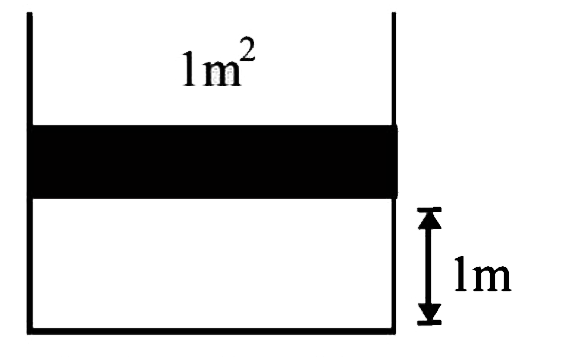A diatomic gas is enclosed in a vessel fitted with massless movable piston. Area of cross section of vessel is 1m2. Initial height of the piston is 1m (see the figure). The initial temperature of the gas is 300K. The temperature of the gas is increased to 400K, keeping pressure constant, calculate the new height of the piston. The piston is brought to its initial position with no heat exchange. Calculate the final temperature of the gas. You can leave answer in fraction.

The correct Answer is:B, C, D
At constant pressure, we have T1V1=T2V2
also, V=A×h
∴T1Ah1=T2Ah2
⇒h2=T2h1T1=400300×1=43m
when the gas is compressed without heat exchange, the
process is adiabatic
∴T'1=T2(V2V1)γ−1=400(43)2/5K
Topper's Solved these Questions
Similar Questions
The piston cylinder arrangement shon contains a diatomic gas at temperature 300 K The crooss sectinal area of the cylinder is 1m2. Initially the height of the piston above th base of the cyclinder is 1 m. The temperature is now raised to 400 K at constatn pressure. Find tge bew jgeauggt if tge oustib avive tge vase if tge cylinder.If the psiton is now brouyght back to its original height without any heat losss, find the new equilibrium temperaturef of the gas. You can leave the answer in fraction.

View SolutionOne mole of a perfect gas in a cylinder fitted with a piston has a pressure P, volume V and temperature T. if the temperature is increased by 1K keeping pressure constant, the increase in volume is
View Solution
Knowledge Check
The initial temperature of a gas is 100∘C . The gas is contained in a closed vessel . If the pressure of the gas is increased by 5% , calculate the increase in temperature of the gas :
A1∘CB2∘CC4∘CD5∘CIf the temperature of a gas is increased by 1K at constant pressure its volume increase by 0.0035 of the initial volume. The temperature of the gas is
A100KB150KC300KD285.7KThe initial temperature of a gas is 100∘C. The gas is contained in closed vessel. If the pressure on the gas is increased by 5% calculate the increase in temperature of the gas
A1∘CB2∘CC4∘CD5∘C
The temperature of a gas contain in a closed vessel increased by 20C when the pressure is increased by 2% the intial temperature of the gas is
View SolutionA gas (λ=1.3) is enclosed in an insulated vessel fitted with insulating piston at a pressure of 105N/m2 . On suddenly pressing the piston the volume is reduced to half the initial volume. The final pressure of the gas is
View SolutionA gas is heated through 2∘C in a closed vessel. Its pressure is increased by 0.4%. The initial temperature of the gas is
View SolutionA gas is heated through 2∘C in a closed vessel. Its pressure is increased by 0.4%. The initial temperature of the gas is
View SolutionWhen a gas filled in a closed vessel is heated through 1∘C , its pressure is increased by 0.4 % . The initial temperature of the gas was
View Solution
